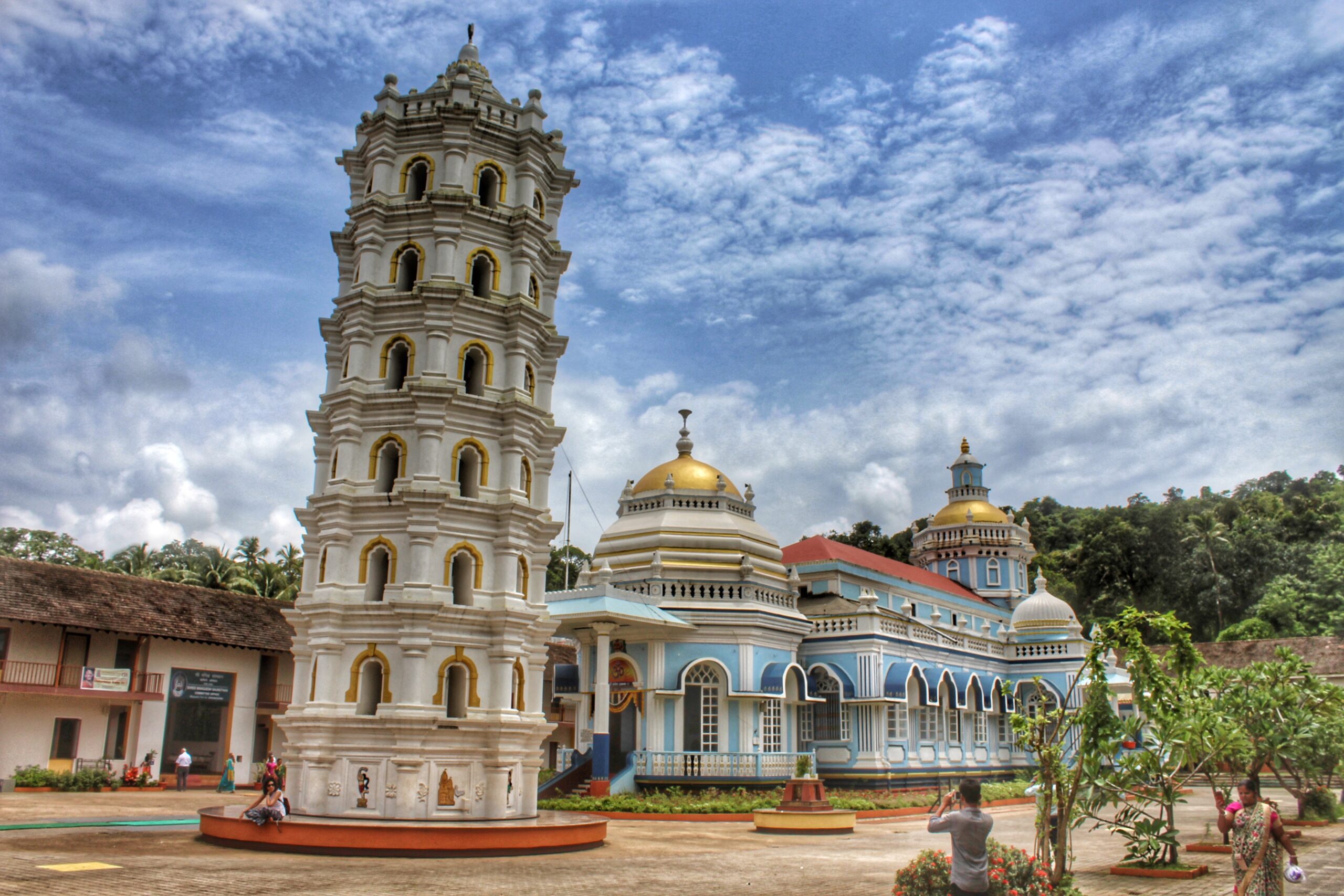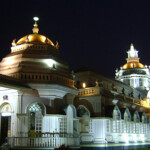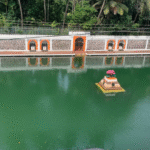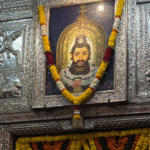
The Shri Mangeshi Temple (also called Mangueshi Temple) is one of the most revered and architecturally significant Hindu temples in Goa. Located in the quiet village of Mangeshi in Priol, near Ponda, it is dedicated to Lord Shiva, worshipped here as Bhagavan Mangesh—a local manifestation of the deity. The name “Mangesh” is derived from a local myth where Goddess Parvati, frightened by Lord Shiva in tiger form, cried out “Trahi Mam Girisha” (“O Lord of the Mountains, save me”). Over time, this became “Mam Girisha” and then “Manguirisha” or “Mangesh.”
Shri Mangeshi Temple, Goa Timings
| Day | Timing |
| Monday | 5:30 AM – 9:30 PM |
| Tuesday | 5:30 AM – 9:30 PM |
| Wedesday | 5:30 AM – 9:30 PM |
| Thursday | 5:30 AM – 9:30 PM |
| Friday | 5:30 AM – 9:30 PM |
| Saturday | 5:30 AM – 9:30 PM |
| Sunday | 5:30 AM – 9:30 PM |
History of Shri Mangeshi Temple, Goa
The Shri Mangeshi Temple has a long and significant history that reflects the religious, cultural, and political shifts in Goa over the centuries. Dedicated to Lord Shiva, the temple’s journey is marked by migration, preservation, and revival.
1. Ancient Roots & Origin
- The deity Mangesh, a form of Lord Shiva, was originally worshipped in a temple located at Kushasthali (modern-day Cortalim) on the banks of the Zuari River.
- The temple at Cortalim was an ancient structure revered by Goud Saraswat Brahmins, an influential Hindu community in Goa.
2. Portuguese Inquisition & Relocation (1560)
- When the Portuguese began enforcing Christianity through the Goan Inquisition in the 16th century, many Hindu temples were destroyed.
- In 1560, to protect the deity from desecration, the idol of Lord Mangesh was secretly relocated by devotees to Priol, in the then safer region under Hindu rule.
- The area of Priol later came under the rule of the Marathas, allowing the temple to be rebuilt and thrive.
3. Maratha Patronage & Reconstruction
- In 1739, the Peshwas of Pune (Maratha rulers) granted the temple village of Mangeshi to the temple priests.
- Over the 18th and 19th centuries, the temple was renovated and expanded with characteristic Goan Hindu architecture—such as the iconic Deepastambha (lamp tower), Sabha Griha (assembly hall), and shikaras (domes).
4. Modern Developments
The temple continued to grow as a center of devotion and community activity.
- In 1973, a golden kalasha (sacred finial) was placed atop the main dome, marking a significant spiritual and architectural milestone.
- Today, the temple is managed by a private temple trust and continues to be a spiritual hub for Goud Saraswat Brahmins and other devotees across India.
Image gallery of Shree Mangesh Temple, Goa
Architecture of Shri Mangeshi Temple
The Shri Mangeshi Temple is a stunning example of Goan Hindu temple architecture, shaped over centuries by regional, Maratha, and even Portuguese influences. Unlike the towering gopurams seen in South India, this temple features a unique blend of simplicity, elegance, and intricate detailing that reflects Goa’s own cultural identity.
Architectural Style
The temple exhibits a fusion of Hindu and colonial-era influences, especially evident in its whitewashed exteriors and European-style arches, combined with traditional Hindu temple elements.
The design emphasizes symmetry, openness, and devotion-centered layout, catering to both spiritual practice and aesthetic appeal.
Key Architectural Features of Shree Mangesh Temple Goa
1. Deepastambha (Lamp Tower)
- A striking seven-story tower, placed at the entrance courtyard.
- This tall structure is lit with oil lamps during major festivals, creating a majestic visual display.
- It serves both religious and symbolic purposes, representing the light of knowledge and divinity.
2. Sabha Griha (Assembly Hall)
- A spacious pillared hall where devotees gather for bhajans and rituals.
- It houses crystal chandeliers, which add a touch of grandeur and are a later addition from the 19th century.
- The hall leads to the Garbhagriha (sanctum), allowing for unobstructed darshan of the main deity.
3. Garbhagriha (Sanctum Sanctorum)
- Houses the Shivalinga of Lord Mangesh, the principal object of worship.
- It is a peaceful, spiritually charged space where only priests are allowed during rituals.
4. Domes and Shikaras
- The temple features rounded white domes instead of the pyramidal towers common in Dravidian temples.
- A golden kalasha (finial) crowns the central dome, added in 1973, symbolizing spiritual fulfillment.
5. Sacred Water Tank
- An ancient rectangular tank believed to predate the temple itself.
- It is used for ritualistic purification and holds cultural importance during major ceremonies.
6. Auxiliary Shrines
- Smaller temples within the complex are dedicated to Parvati, Ganesha, Nandi, Bhairav, and Garuda.
- These ensure a complete representation of the divine family and Hindu cosmology.
Opening & Closing Timings of Shri Mangeshi Temple
The Shri Mangeshi Temple remains open to devotees throughout the day with specific timings for darshan and rituals.
Shree Mangesh Temple Timings:
- Morning: 5:00 AM to 12:30 PM
- Evening: 4:00 PM to 9:00 PM
These timings may slightly vary on special occasions or during major festivals like Mahashivratri or Magha Poornima Jatra, when the temple may remain open longer for rituals and celebrations.
Shree Mangesh Temple Goa Visitor Tips:
- Try to visit early in the morning for peaceful darshan.
- Monday evenings are special for the palanquin procession.
- The temple remains less crowded on weekdays and outside of major holidays.
How to Reach Shri Mangeshi Temple
The Shri Mangeshi Temple is located in the peaceful village of Mangeshi in Priol, Ponda taluka—roughly midway between Goa’s capital Panaji and the major town of Margao. It is easily accessible by road from most parts of Goa.
1. By Road
- The temple is well connected by Goa’s local road network.
- You can reach it via bus, taxi, rented scooter, or private vehicle.
- Good signboards and local guidance are available en route.
By Taxi or Cab
- Prepaid taxis, app-based cabs (GoaMiles, Uber local), or private rentals are convenient and comfortable, especially for tourists.
- You can also hire a cab for a full-day temple tour including Shanta Durga Temple and other nearby attractions.
By Bike/Scooter
- Scooters and bikes can be rented in most Goan cities/towns.
- Ideal for budget and flexible travelers who want to explore nearby temples and spice plantations.
By Bus
- Local buses run regularly between Panaji, Ponda, and Priol.
- From Ponda Bus Stand, you can take a rickshaw or local bus to reach the temple (approx. 4–5 km away).
2. By Air
- Nearest Airport: Goa International Airport (Dabolim) – about 30 km away.
- From the airport, taxis and rental cars are available to reach the temple directly.
3. By Train
Nearest Railway Stations:
- Karmali Station (~17 km)
- Margao Station (Madgaon) (~26 km)
From either station, you can hire a cab or take a bus toward Ponda/Priol.
Places to explore near Shri Mangeshi Temple
Located in the spiritual and cultural heartland of Ponda taluka, the Shri Mangeshi Temple is surrounded by other prominent temples, spice plantations, and heritage sites—making it perfect for a half- or full-day cultural tour.
1. Shanta Durga Temple (Approx. 4 km)
A major pilgrimage site, this temple is dedicated to Goddess Shantadurga, a peaceful form of Durga. Known for its Indo-Portuguese architecture, it features a large tank, deepstambha (lamp tower), and an impressive domed structure.
2. Mahalsa Narayani Temple, Mardol (Approx. 2 km)
Dedicated to Goddess Mahalsa (a form of Mohini, Vishnu’s female avatar), this temple is admired for its intricate woodwork, tall samai (brass oil lamp), and beautiful carvings.
3. Ponda Wildlife & Bondla Wildlife Sanctuary (Approx. 20 km)
Perfect for nature lovers, Bondla offers a mini zoo, deer safari park, and nature trails. It’s a serene escape into Goa’s lush Western Ghats.
4. Tropical Spice Plantation (Approx. 6 km)
A guided tour through this spice plantation lets you explore Goa’s rich agricultural heritage—try local flavors, elephant rides, and traditional Goan meals.
5. Big Foot Loutolim (Approx. 20 km)
An open-air museum and cultural center showcasing traditional Goan life, local folklore, and craftsmanship—great for cultural immersion.
Best Time to Visit Shri Mangueshi Temple Goa
- October to March is ideal due to pleasant weather.
- Mondays and Mahashivratri Festival are spiritually significant.
- Temple festivals like Rathotsava (Chariot festival) are also celebrated with grandeur.
Conclusion
The Shri Mangeshi Temple in Goa is more than just a place of worship – it is a spiritual, architectural, and cultural marvel. Whether you are a pilgrim seeking divine blessings, a traveler exploring Goan heritage, or simply someone looking for a peaceful experience, this temple is a must-visit destination.
So, if you’re in Goa, do take time to visit this sacred Shiva temple, soak in its divine aura, attend the mesmerizing aarti, and witness the blend of devotion, history, and tradition.
FAQs About Shree Mangesh Temple, Goa
What is the nearest airport to Shri Mangeshi Temple?
Goa International Airport (Dabolim) – approximately 28 km away.
What is the significance of the temple?
It is dedicated to Lord Shiva in his Mangesh form, and is a major spiritual site for the Gaud Saraswat Brahmin community.
Are non-Hindus allowed to visit?
Yes, the temple welcomes all respectful visitors, but some inner sanctum areas may be restricted.
Are there shops nearby?
Yes, you will find prasad stalls, small souvenir shops, and local eateries around the temple premises.









